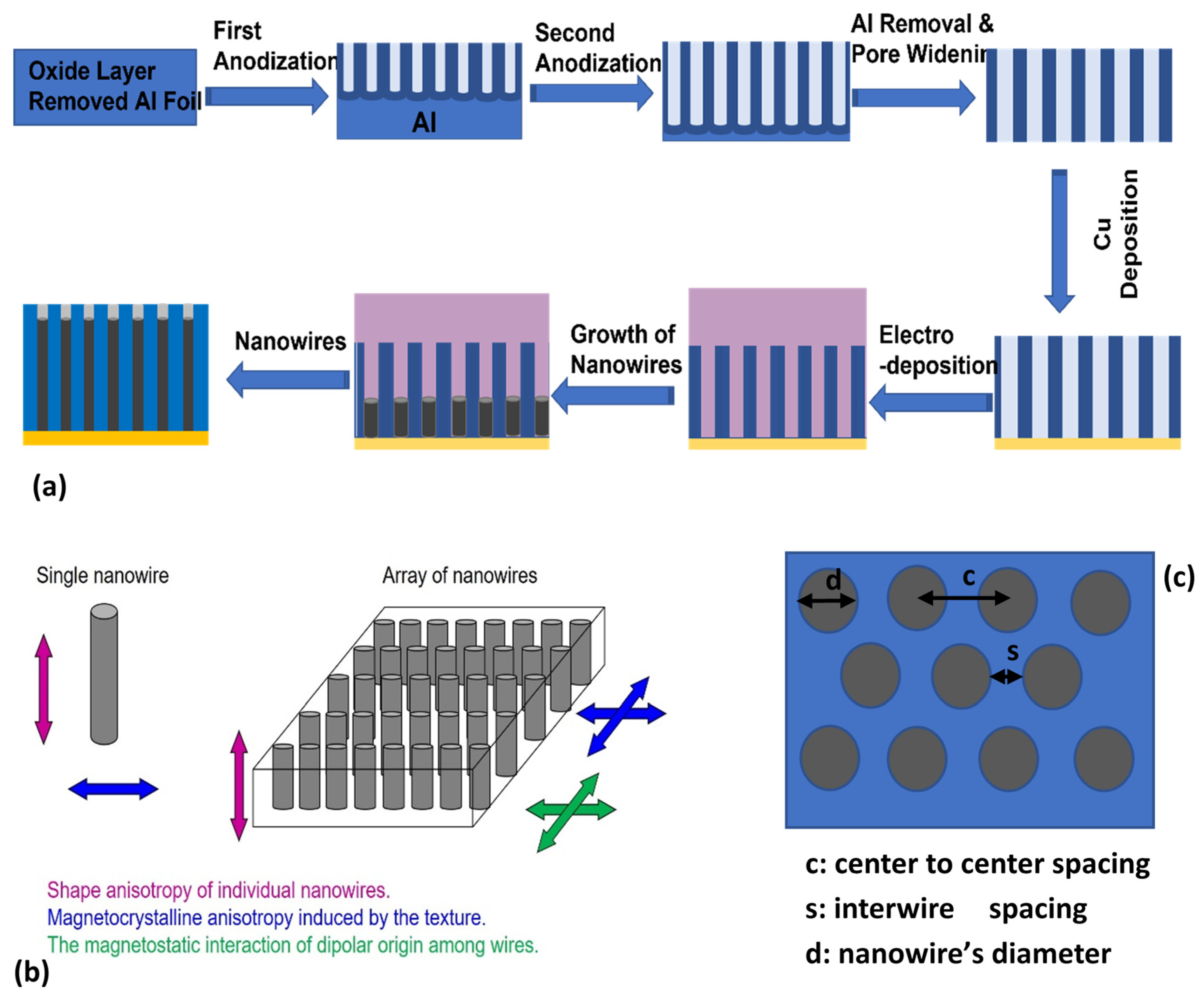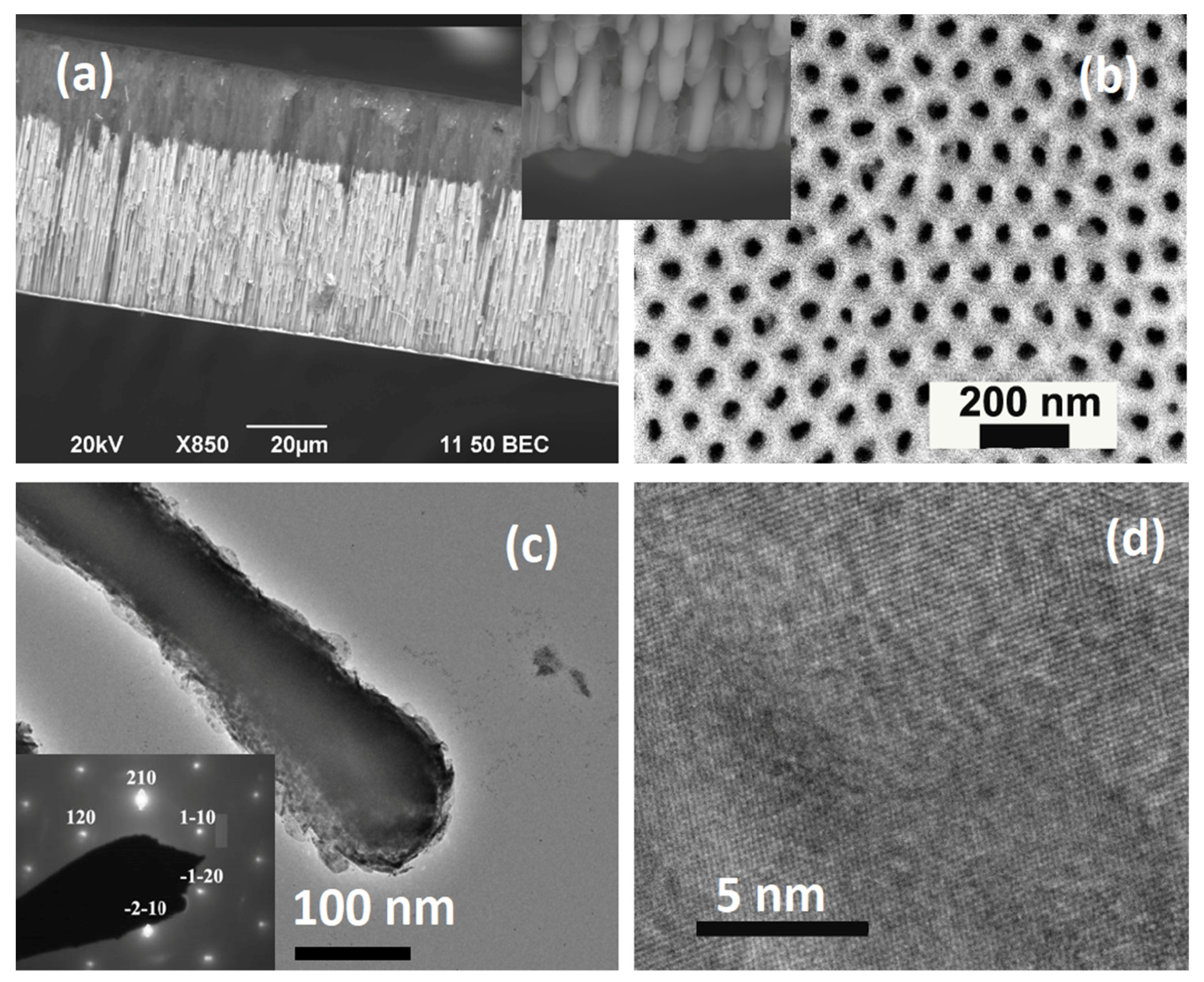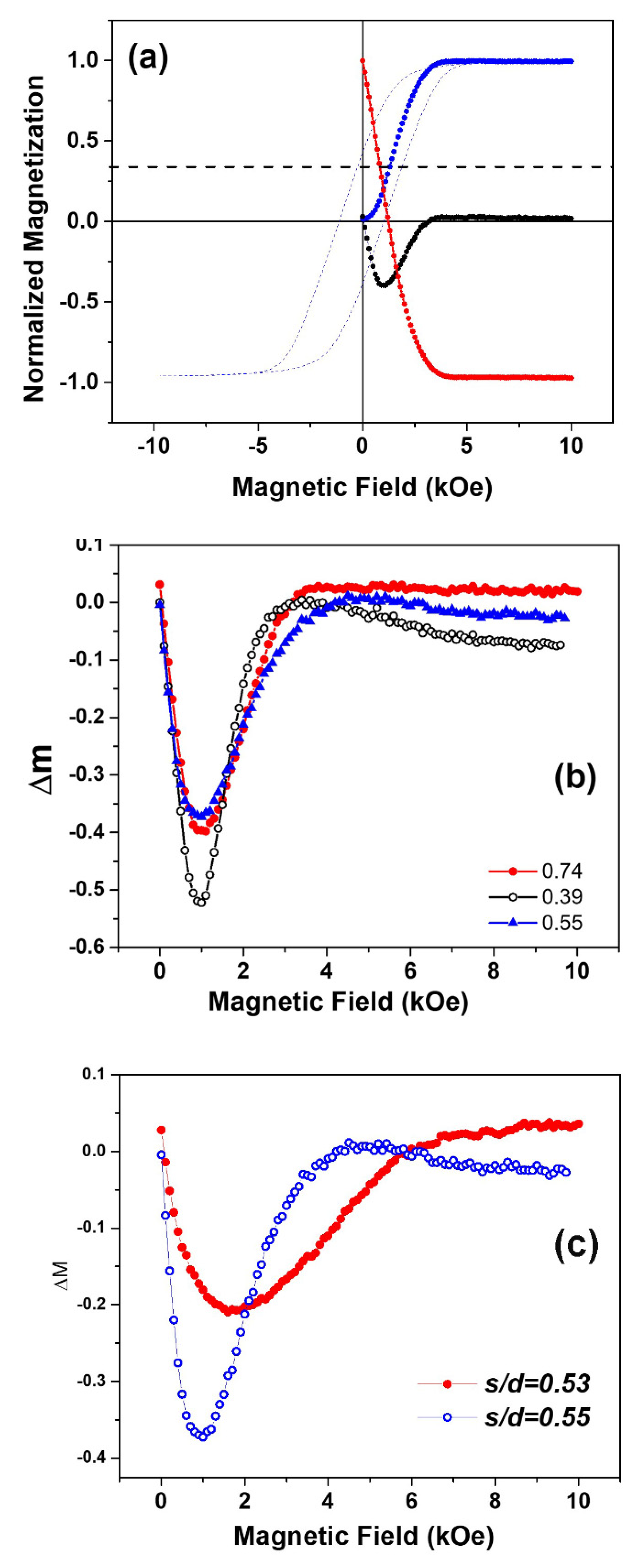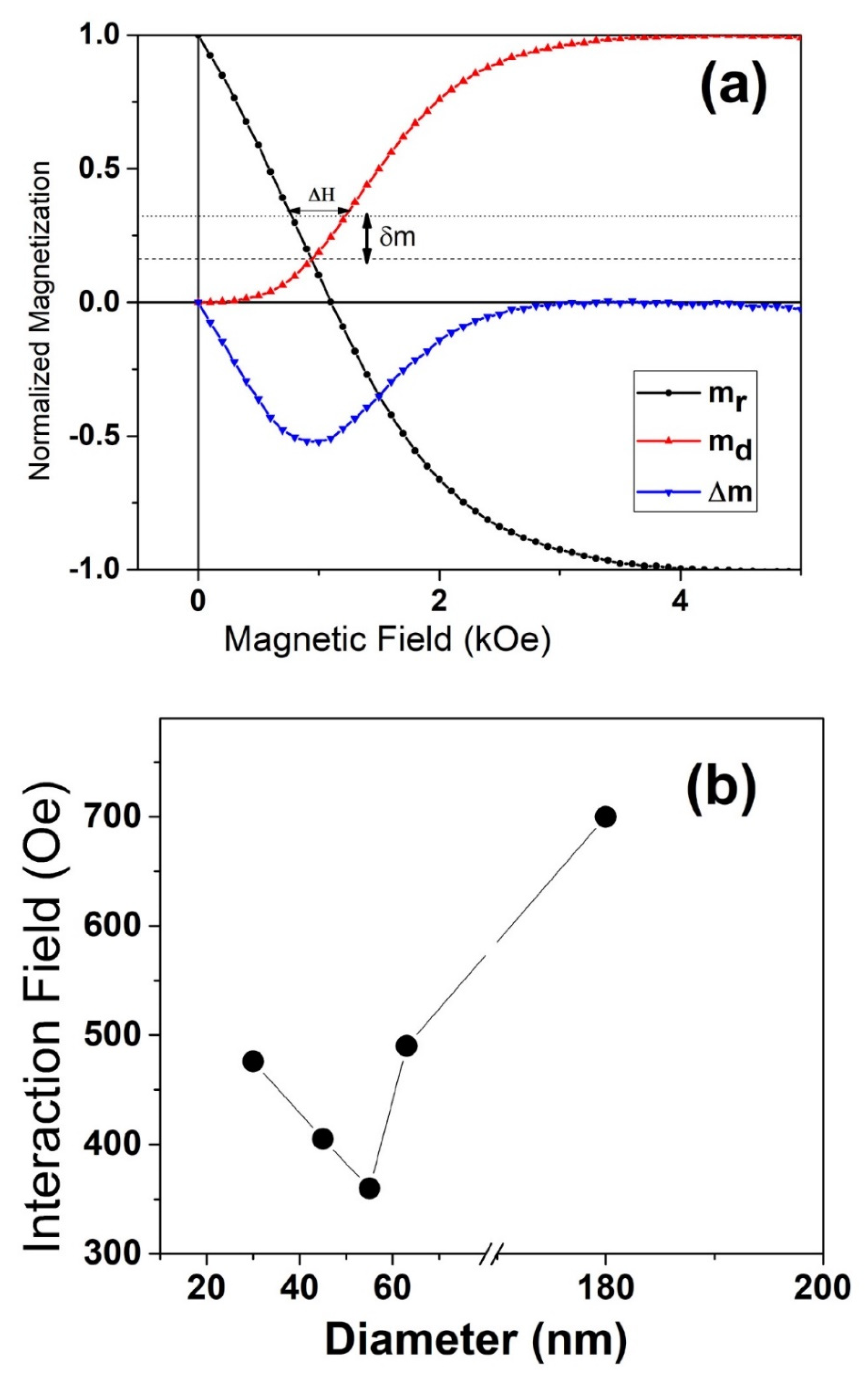Tuning Easy Magnetization Direction and Magnetostatic Interactions in High Aspect Ratio Nanowires
Abstract
:1. Introduction
2. Materials and Methods
2.1. Materials Synthesis
2.2. Analytical Methods
3. Results and Discussion
4. Conclusions
Author Contributions
Funding
Conflicts of Interest
References
- Piraux, L. Magnetic nanowires. Appl. Sci. 2020, 10, 1832. [Google Scholar] [CrossRef] [Green Version]
- Bantu, A.K.M.; Rivas, J.; Zaragoza, G.; López-Quintela, M.A.; Blanco, M.C. Structure and magnetic properties of electrodeposited cobalt nanowires. J. Appl. Phys. 2001, 89, 3393–3397. [Google Scholar] [CrossRef]
- Gandha, K.; Elkins, K.; Poudyal, N.; Liu, X.; Liu, J.P. High energy product developed from cobalt nanowires. Sci. Rep. 2014, 4, 5345. [Google Scholar] [CrossRef] [PubMed] [Green Version]
- Sun, L.; Hao, Y.; Chien, C.L.; Searson, P.C. Tuning the properties of magnetic nanowires. IBM J. Res. Dev. 2005, 49, 79–102. [Google Scholar] [CrossRef]
- Patsopoulos, A.; Kechrakos, D.; Moutis, N. Magnetic properties of nanowires with ferromagnetic core and antiferromagnetic shell. J. Magn. Magn. Mater. 2019, 475, 171–175. [Google Scholar] [CrossRef]
- Narayanan, T.N.; Shaijumon, M.M.; Ci, L.; Ajayan, P.M.; Anantharaman, M.R. On the growth mechanism of nickel and cobalt nanowires and comparison of their magnetic properties. Nano Res. 2008, 1, 465–473. [Google Scholar] [CrossRef] [Green Version]
- Elbaile, L.; Crespo, R.D.; Vega, V.; García, J.A. Magnetostatic interaction in Fe-Co nanowires. J. Nanomater. 2012, 2012. [Google Scholar] [CrossRef] [Green Version]
- Fodor, P.S.; Tsoi, G.M.; Wenger, L.E. Investigation of magnetic interactions in large arrays of magnetic nanowires. J. Appl. Phys. 2008, 103, 07B713. [Google Scholar] [CrossRef] [Green Version]
- Geshev, J.; Mikhov, M.; Schmidt, J.E. Remanent magnetization plots of fine particles with competing cubic and uniaxial anisotropies. J. Appl. Phys. 1999, 85, 7321–7327. [Google Scholar] [CrossRef] [Green Version]
- Araujo, E.; Martínez-Huerta, J.M.; Piraux, L.; Encinas, A. Quantification of the Interaction Field in Arrays of Magnetic Nanowires from the Remanence Curves. J. Supercond. Nov. Magn. 2018, 31, 3981–3987. [Google Scholar] [CrossRef]
- Raposo, V.; Zazo, M.; Flores, A.G.; Garcia, J.; Vega, V.; Iñiguez, J.; Prida, V.M. Ferromagnetic resonance in low interacting permalloy nanowire arrays. J. Appl. Phys. 2016, 119, 143903. [Google Scholar] [CrossRef]
- Cabria, I.; Prida, V.M. Magnetostatic dipolar anisotropy energy and anisotropy constants in arrays of ferromagnetic nanowires as a function of their radius and interwall distance. J. Phys. Commun. 2020, 4, 035015. [Google Scholar] [CrossRef] [Green Version]
- Corradi, A.R.; Wohlfarth, E.P. Influence of densification on the remanence, the coercivities and the interaction field of elongated γFe2O3 powders. IEEE Trans. Magn. 1978, 14, 861–863. [Google Scholar] [CrossRef]
- Álvarez, N.; Sallica Leva, E.; Valente, R.C.; Vásquez Mansilla, M.; Gómez, J.; Milano, J.; Butera, A. Correlation between magnetic interactions and domain structure in A1 FePt ferromagnetic thin films. J. Appl. Phys. 2014, 115, 083907. [Google Scholar] [CrossRef] [Green Version]
- Zhou, Z.; Nonnenmann, S.S. Progress in nanoporous templates: Beyond anodic aluminum oxide and towards functional complex materials. Materials 2019, 12, 2535. [Google Scholar] [CrossRef] [Green Version]
- Khurshid, H.; Huang, Y.H.; Bonder, M.J.; Hadjipanayis, G.C. Microstructural and magnetic properties of CoPt nanowires. J. Magn. Magn. Mater. 2009, 321, 277–280. [Google Scholar] [CrossRef]
- Maijenburg, W. Templated Electrodeposition of Functional Nanostructures. Ph.D. Thesis, University of Twente, Enschede, The Netherlands, 2014. [Google Scholar]
- Dobosz, I. Influence of the anodization conditions and chemical treatment on the formation of alumina membranes with defined pore diameters. J. Porous Mater. 2021, 28, 1011–1022. [Google Scholar] [CrossRef]
- Dávalos, E.; López, R.; Ruiz, H.; Méndez, A.; Antaño-López, R.; Trejo, G. Study of the role of boric acid during the electrochemical deposition of Ni in a sulfamate bath. Int. J. Electrochem. Sci. 2013, 8, 9785–9800. [Google Scholar]
- Maaz, K.; Karim, S.; Usman, M.; Mumtaz, A.; Liu, J.; Duan, J.L.; Maqbool, M. Effect of crystallographic texture on magnetic characteristics of cobalt nanowires. Nanoscale Res. Lett. 2010, 5, 1111–1117. [Google Scholar] [CrossRef] [PubMed] [Green Version]
- Liu, Z.; Chang, P.C.; Chang, C.C.; Galaktionov, E.; Bergmann, G.; Lu, J.G. Shape anisotropy and magnetization modulation in hexagonal cobalt nanowires. Adv. Funct. Mater. 2008, 18, 1573–1578. [Google Scholar] [CrossRef]
- Muscas, G.; Concas, G.; Laureti, S.; Testa, A.M.; Mathieu, R.; De Toro, J.A.; Cannas, C.; Musinu, A.; Novak, M.A.; Sangregorio, C.; et al. The interplay between single particle anisotropy and interparticle interactions in ensembles of magnetic nanoparticles. Phys. Chem. Chem. Phys. 2018, 20, 28634–28643. [Google Scholar] [CrossRef] [PubMed] [Green Version]
- Prida, V.M.; García, J.; Hernando, B.; Bran, C.; Vivas, L.G.; Vázquez, M. Electrochemical synthesis of magnetic nanowires with controlled geometry and magnetic anisotropy. In Magnetic Nano- and Microwires: Design, Synthesis, Properties and Applications’ Woodhead Publishing Series in Electronic and Optical Materials; Woodhead Publishing: Swaston, UK, 2015; ISBN 9780081001646. [Google Scholar]
- Wohlfarth, E.P. Relations between different modes of acquisition of the remanent magnetization of ferromagnetic particles. J. Appl. Phys. 1958, 29, 595. [Google Scholar] [CrossRef]






| Electrolyte | Concentration | Voltage | Diameter |
|---|---|---|---|
| C2H2O4 | 0.3 M | 40 V | 60 nm |
| C2H2O4 | 0.3 M | 30 V | 55 nm |
| C2H2O4 | 0.3 M | 25 V | 45 nm |
| H2SO4 | 0.3 M | 20 V | 30 nm |
| Diameter D (nm) | Interwire Spacing S (nm) | Preferred Orientation | Ratio s/d | δm | Interaction Field | P = 3.67 (d/s)2 | |
|---|---|---|---|---|---|---|---|
| HI | 30 | 25 | Parallel | 0.74 | 0.13 | 714 | 5.3 |
| H2 | 45 | 27 | Perpendicular | 0.61 | 0.13 | 608 | 10.2 |
| H3 | 55 | 30 | Perpendicular | 0.55 | 0.11 | 548 | 12.3 |
| H4 | 188 | 100 | Perpendicular | 0.53 | 0.0667 | 1050 | 14.7 |
| H5 | 60 | 24 | - | 0.40 | 0.167 | 722 | 23 |
Publisher’s Note: MDPI stays neutral with regard to jurisdictional claims in published maps and institutional affiliations. |
© 2021 by the authors. Licensee MDPI, Basel, Switzerland. This article is an open access article distributed under the terms and conditions of the Creative Commons Attribution (CC BY) license (https://creativecommons.org/licenses/by/4.0/).
Share and Cite
Khurshid, H.; Yoosuf, R.; Issa, B.A.; Attaelmanan, A.G.; Hadjipanayis, G. Tuning Easy Magnetization Direction and Magnetostatic Interactions in High Aspect Ratio Nanowires. Nanomaterials 2021, 11, 3042. https://doi.org/10.3390/nano11113042
Khurshid H, Yoosuf R, Issa BA, Attaelmanan AG, Hadjipanayis G. Tuning Easy Magnetization Direction and Magnetostatic Interactions in High Aspect Ratio Nanowires. Nanomaterials. 2021; 11(11):3042. https://doi.org/10.3390/nano11113042
Chicago/Turabian StyleKhurshid, Hafsa, Rahana Yoosuf, Bashar Afif Issa, Atta G. Attaelmanan, and George Hadjipanayis. 2021. "Tuning Easy Magnetization Direction and Magnetostatic Interactions in High Aspect Ratio Nanowires" Nanomaterials 11, no. 11: 3042. https://doi.org/10.3390/nano11113042






